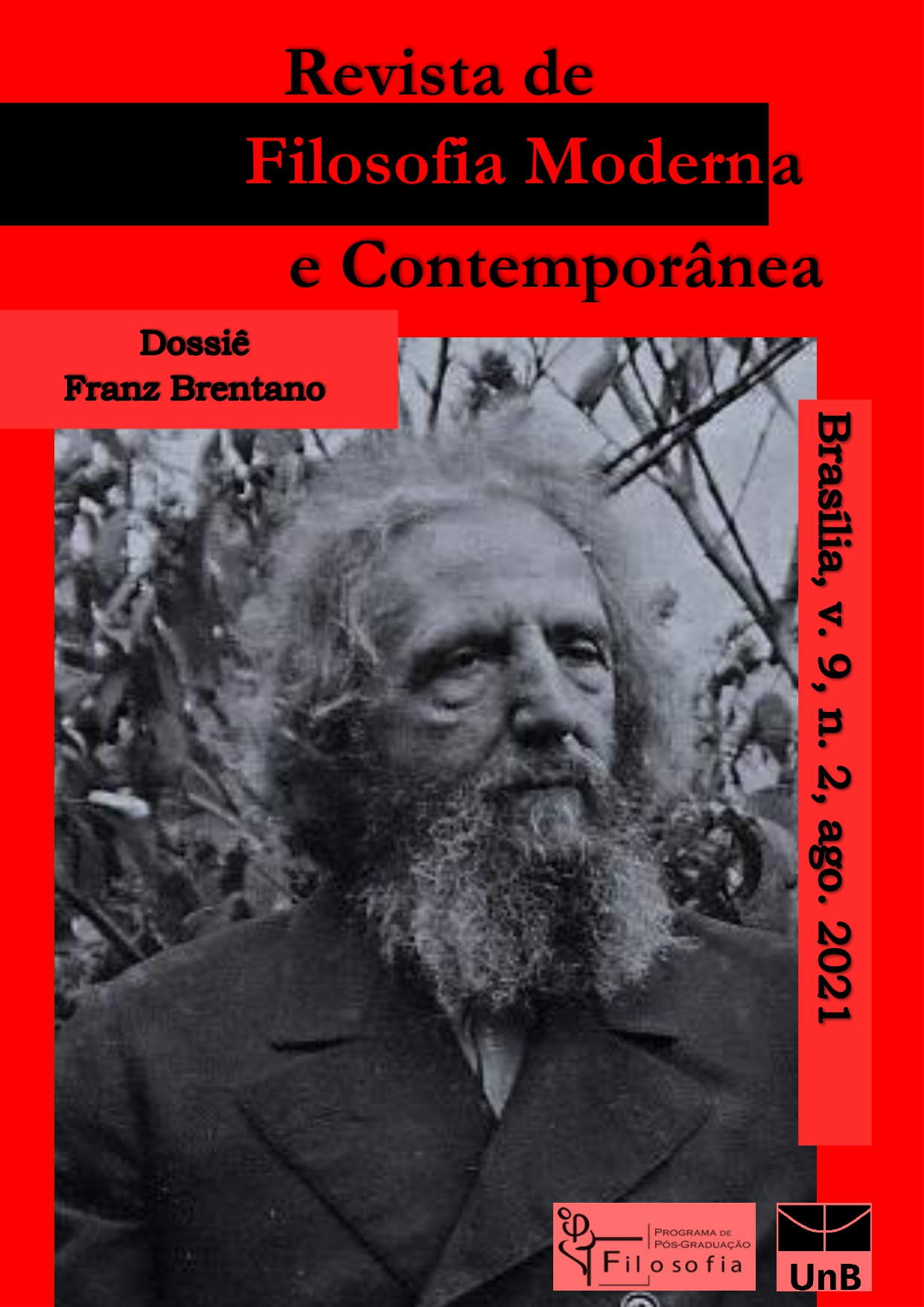Sobre Ur-intencionalidade
DOI:
https://doi.org/10.26512/rfmc.v9i2.42920Palavras-chave:
Ur-intencionalidade. Enativismo radical. Teleosemântica. Cognição básica. Atributivismo de conteúdo.Resumo
Iniciando pela caracterização clássica de intencionalidade proporcionada por Brentano, nós fazemos uma revisão crítica da proposta enativista radical com relação à cognição básica no intuito de mostrar que o pressuposto de que nada ficaria perdido com a remoção dos compromissos representacionalistas da teleosemântica é injustificado. Argumentamos que algumas características importantes da cognição básica ficam perdidas com a RE(C)tificação da teleosemântica, as quais resgatamos pelo esboço de uma alternativa cunhada atributivismo-de-conteúdo livre de compromissos metafísicos.
Downloads
Referências
BASTAKOV, V. A. “Visual illusions in Frogs and Toads”. Perception, v. 26, n. 1, suppl, pp. 80-80, 1997.
____. “Size Constancy Mechanism and Spatial Illusions in an Anuran”. Perception, v. 37, n. 1, suppl, pp. 158-158, 2008.
BRENTANO, Franz. Psychology from an Empirical Standpoint (1874). Edited by Linda L. McAlister. Translated by Antos C. Rancurello et al. New York, London: Routledge, 1995.
COLOMBO, M. “Neural Representationalism, the Hard Problem of Content and Vitiated Verdicts. A Reply to Hutto Myin (2013).” Phenomenology and the Cognitive Sciences, v. 13, n. 2, pp. 257-274, 2014.
CRANE, T. “Brentano’s Concept of Intentional Inexistence.” In: TEXTOR, M. (Ed.) The Austrian Contribution to Analytic Philosophy, London, New York: Routledge, 2006 (pp. 20-35).
____. “Intentionalism.” In: BECKERMANN, A.; McLAUGHLIN, B.; WALTER, S. (Eds.) The Oxford Handbook of Philosophy of Mind. Oxford: Oxford University Press, 2009 (pp. 474-493).
EVANS, G. The Varieties of Reference. Edited by J. H. McDowell. Oxford: Clarendon Press, 1982.
FODOR, J. A Theory of Content and Other Essays. Cambridge, MA: The MIT Press, 1990.
____. “Deconstructing Dennett’s Darwin.” Mind and Language, v. 11, n. 3, pp. 246-262, 1996.
GALLISTEL, C. R. “Symbolic Processes in the Brain: The Case of Insect Navigation”. In: SCARBOROUGH, D.; STERNBERG, S. (Eds.) An Invitation to Cognitive Science, Vol. 4: Methods, Models, and Conceptual Issues, 2nd ed., Cambridge, MA: The MIT Press, 1998.
GOZZANO, S. “The Beliefs of Mute Animals.” In: MARRAFFA, M.; DE CARO, M.; FERRETTI, F. (Eds.) Cartographies of the Mind, Dordrecht: Springer, 2007 (pp. 271-282).
GRICE, P. Studies in the Way of Words. Cambridge, MA: Harvard University Press, 1989.
HAUGELAND, J. “The Intentionality All-Stars.” Philosophical Perspectives, v. 4, pp. 383-427, 1990.
HUTTO, D. D. Folk Psychological Narratives: The Sociocultural Basis of Understanding Reasons. Cambridge, MA: The MIT Press, 2008.
____. “Philosophy of Mind’s New Lease on Life: Autopoietic Enactivism meets Teleosemiotics.” Journal of Consciousness Studies, v. 18, n. 5-6, pp. 44-64, 2011.
HUTTO, D. D.; MYIN, E. Radicalizing Enactivism: Basic Minds without Content. Cambridge, MA: The MIT Press, 2013.
____. Evolving Enactivism: Basic Minds Meet Content. Cambridge, MA: The MIT Press, 2017.
____. “Much Ado About Nothing? Why Going Non-Semantic is not Merely Semantics.” Philosophical Explorations, v. 21, n. 2, pp. 187-203, 2018.
HUTTO, D. D.; SATNE, G. “Introduction: Searching for the Natural Origins of Content.” Philosophia, v. 43, n. 3, pp. 505-519, 2015.
McCLOSKEY, M. Visual Reflections: A Perceptual Deficit and Its Implications, New York: Oxford University Press, 2009.
MIKLOSI, A. Dog Behaviour, Evolution, and Cognition. Oxford: Oxford University Press, 2007.
MILLIKAN, R. “Speaking Up for Darwin.” In: LOEWER, B.; REY, G. (Eds.) Meaning in Mind: Fodor and His Critics, Oxford: Blackwell, 1991 (pp. 151–164).
MULLER, H. D. “Naturalism and Intentionality”. In: BASHOUR, B.; MULLER, H. D. (Eds.) Contemporary Philosophical Naturalism and Its Implications, London: Routledge, 2014.
NEANDER, K. “Misrepresenting Malfunctioning.” Philosophical Studies, v. 79, n. 2, pp. 109-141, 1995.
____. A Mark of the Mental: In Defense of Informational Teleosemantics. Cambridge, MA: The MIT Press, 2017.
PIETROSKI, P. “Intentionality and Teleological Error.” Pacific Philosophical Quarterly, v. 73, n. 3, pp. 267-282, 1992.
ROY, J.-M. “Anti-Cartesianism and Anti-Brentanism: The Problem of Anti-Representationalist Intentionalism.” The Southern Journal of Philosophy, v. 53, Spindel Supplement, pp. 90–125, 2015.
SCHULTE, P. “How Frogs See the World: Putting Millikan’s Teleosemantics to the Test.” Philosophia, v. 40, n. 3, pp. 483-496, 2012.
SIEWERT, C. “Consciousness and Intentionality.” In: ZALTA, E. N. (Ed.) The Stanford Encyclopedia of Philosophy (Spring 2017 Edition), URL=https://plato.stanford.edu/archives/spr2017/entries/consciousness-intentionality/
SMITH, B. Austrian Philosophy. La Salle, IL: Open Court, 1994.
SIMONS, P. “Mind and Opacity.” Dialectica, v. 49, n. 2-4, pp. 131-146, 1995.
THOMPSON, E. “Review of Daniel D. Hutto and Erik Mying, Evolving Enactivism: Basic Minds Meet Content.” Notre Dame Philosophical Reviews, January 11, 2018.
TWARDOWSKI, K. On the Content and Object of Presentations: A Psychological Investigation (1894). Translated by Richard Grossmann. The Hague: Martinus Nijhoff, 1977.
Downloads
Publicado
Como Citar
Edição
Seção
Licença
Copyright (c) 2021 Revista de Filosofia Moderna e Contemporânea

Este trabalho está licenciado sob uma licença Creative Commons Attribution-NonCommercial-NoDerivatives 4.0 International License.
Direitos Autorais para artigos publicados nesta revista são do autor, com direitos da primeira publicação para a revista. Em virtude dos artigos aparecerem nesta revista de acesso público, os artigos são de uso gratuito, com atribuições próprias, em aplicações educacionais e não-comerciais.


